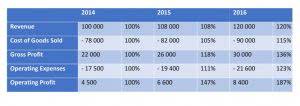How to Account for Prepaid Insurance? Definition, Classification, Journal Entries, and Example

The payment of the insurance expense is similar to money in the bank—as that money is used up, it is withdrawn from the account in each month or accounting period. Under the cash basis an organization would immediately record the full amount of the purchase of a good or service to the income statement as soon as the cash is paid. Each month, the business’s accounting department would prepaid insurance make an adjusting journal entry of $1,000, representing the amount of one month’s premium payment in the general ledger.
- Under the cash basis an organization would immediately record the full amount of the purchase of a good or service to the income statement as soon as the cash is paid.
- Because prepayments they are not yet incurred, they should not be classified as expenses.
- The one-year period for the insurance rarely coincides with the company’s accounting year.
- This is due to one asset increases $1,200 and another asset decreases $1,200.
- In other words, these are “advanced payments” by a company for supplies, rent, utilities and others, that are still to be consumed.
- The adjusting entry for prepaid expense depends upon the journal entry made when it was initially recorded.
- Abdul Co. has a new insurance policy that requires them to pay $2,400 per year, in a lump sum manner.
What is prepaid insurance an example of? ›

Prepaid insurance is of great importance to any business, as it ensures that there is no loss in insurance coverage due to missed payments. Advance payment of insurance enables a business to manage its cash flow and budget since it assures that insurance needs are covered for the prepaid period. If the prepayment covers a longer period, then classify the portion of the prepaid insurance that will not be charged to expense within one year as a long-term asset. Unless an insurance claim is filed, prepaid insurance is usually renewable by the policyholder shortly before the expiry date on the same terms and conditions as the original insurance contract.
- At the end of each month, the company usually make the adjusting entry for insurance expense to recognize the cost of that has expired during the period.
- Alternatively, if the organization has paid in advance for a particular service, it is disclosed as a Current Asset.
- For example, a $12,000 payment for a one-year policy results in a $12,000 debit to Prepaid Insurance and a $12,000 credit to Cash.
- However, to ensure accuracy of financial statements, it is essential that these are recorded in the correct accounting period.
- A detailed schedule, often called an amortization schedule, aids this process.
- When they aren’t used up or expired, these payments show up on an insurance company’s balance sheet.
Journal Entry
However, prepaid health cards are now available so find one that suits your capacity to pay. With prepaid HMOs, you can quickly access care without worrying about hidden costs or long processing times, making healthcare more convenient and reliable. Prepaid HMOs provide the flexibility to choose the plan that best fits your health needs, whether it’s for individuals, families, or specific health services. In the example above, it can be seen that Abdul Co. has made an annual payment for insurance, amounting to $2,400. This amount corresponds to 12 months, beginning on 1st July 2019, and ending on 30th June 2020. This implies that only the current charge is going to be recorded as an expense in the Income Accounts Payable Management Statement.
prepaid insurance

Now if this were a short-term lease, then a prepaid asset would be recognized on the balance sheet for prepaid rent expense. However, under the new lease accounting pronouncements, the guidance eliminates recognizing prepaid assets on the balance sheet related to leases exceeding a total lease term of 12 months. Rather, any prepaid rent pertaining to a long-term lease would be rolled into the ROU asset balance recognized on the balance sheet. The most-common examples of prepaid expenses in accounting are prepaid rent from leases, prepaid software subscriptions, and prepaid insurance premiums.
- The adjusting entry involves debiting Insurance Expense and crediting Prepaid Insurance for the amount corresponding to the expired portion ($1,000 in the example).
- The balance in this account will be combined with the balances in other prepaid expense accounts and will be listed on the balance sheet as prepaid expenses.
- Some regulatory bodies may also require businesses to disclose prepaid insurance balances separately if they represent a significant portion of assets.
- Insurance expense, as an expense is treated in the same way as other expenses that are incurred.
This provides up to Php 50,000 worth of outpatient emergency and inpatient coverage on emergency cases due to accidents. Great if you drive most days, and want liability coverage on a budget-friendly payment plan. Let us look at the balance sheet at the end of one month on December 31, 2017. Thus, out of the $1,500, $900 worth of supplies have been used and $600 remain unused. The $900 must then be recognized as expense since it has already been used. Take note that the amount has not yet been incurred, thus it is proper to record it as an asset.

To illustrate prepaid insurance, let’s assume that on November 20 a company pays an insurance premium of $2,400 for insurance protection during the six-month period of December 1 through May 31. On November 20, the payment is entered with a debit of $2,400 to Prepaid Insurance and a credit of accounting $2,400 to Cash. Prepaid expenses, or Prepaid Assets as they are commonly referred to in general accounting, are recognized on the balance sheet as an asset.
Prepaid Insurance Journal Entry: Recording and Adjusting in Accounting
That’s why iCare’s prepaid HMO in the Philippines offers a solution to these challenges by providing a clear, upfront payment structure that eliminates the worry of unforeseen bills. Prepaid insurance is also considered an asset because of its redeemable value. Any remaining prepaid portion of the premium could be redeemed or refunded to the business if the business cancels the policy before the period covered by those premiums has expired.

How to record prepaid insurance
It is considered a prepaid asset, which is a way to express these benefits in accounting terms. The journal entries above shows how insurance expense is treated, in case of prepayments. Therefore, in accordance to this principle, prepaid insurance would be treated as a Current Asset in the year when the advance payment is made. In the subsequent year, when insurance is lapsed, then the amount will be deducted as an expense from the Income Statement.

